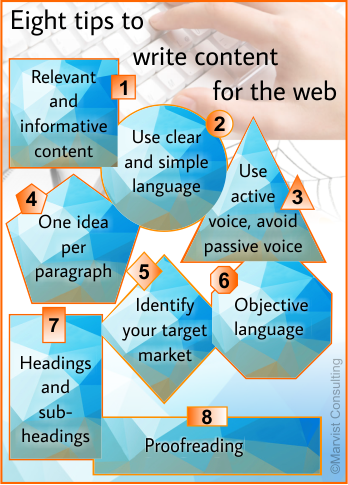Date Published: 26-Jun-2013 | Author: Kerry K Robinson
 Writing content for the Web? Great. But to attract a large number of visitors, you need to write content that visitors are looking for. If you know your subject well, you could write content in your niche. Remember, you’re writing for audiences who are different from those who read newspapers, journals or watch television to get information and knowledge. Your job as a Web content writer is to provide content in such a way that it has great usability and that is easy-to-understand. Here are eight tips that you will find helpful while writing content for the Web.
Writing content for the Web? Great. But to attract a large number of visitors, you need to write content that visitors are looking for. If you know your subject well, you could write content in your niche. Remember, you’re writing for audiences who are different from those who read newspapers, journals or watch television to get information and knowledge. Your job as a Web content writer is to provide content in such a way that it has great usability and that is easy-to-understand. Here are eight tips that you will find helpful while writing content for the Web.
Tip 1: Relevant and informative content
Keeping your audience in mind, create relevant and valuable content. By relevant content we mean information that is relevant to a particular topic and audience. Assume you are a website designer and planning to write content on web designing, you can write on, ‘tips to improve your website usability’, ‘how to make your website aesthetically appealing’, etc. Here, we emphasize on writing informative, unique, original and authoritative content.
Tip 2: Use clear and simple language
When you write on the Web, you are writing for a global audience. You need to be clear and use simple language. This makes it easier for your audience to understand and remember the facts, etc. Avoid using complex words or slang.
Further, the quality of the content depends on its simplicity. The simpler the content is, the less time it takes for the readers to understand. Use of simple language is associated with making things simpler however complex they are. Also avoid needless jargon.
Tip 3: Use active voice, avoid passive voice
Using active voice shows that you are closer and connected to your audiences. It makes it easy for you audience to understand your content. The sentences in active voice are shorter than in passive voice. The meaning becomes hard to understand in passive voice.
Active voice as the very name suggests, is likely to prompt your audience to be more attentive. Using passive voice gives an impression that you rarely like to converse frankly with your audiences, and that you like to maintain distance.
Here is an example written in both active voice and passive voice:
- Active voice: We are going to watch a movie tonight.
- Passive voice: A movie is going to be watched by us tonight.
Tip 4: One idea per paragraph
Divide the content into ideas. Limit each idea to a single paragraph. If you give multiple points in one paragraph, you are likely to confuse your audience. You are also likely to divert from the topic and lose track. Keeping one idea per paragraph really works and readers will be interested to know what each paragraph holds for them.
Tip 5: Identify your target market
First, know who your audiences are and what aspect in your niche they are interested in. These audiences are your target market and are potential buyers. They are valuable assets for your business, so write content that helps them in decision making and buying process.
Tip 6: Objective language
Be objective while writing. Supportive facts from experience are likely to make your content credible. Don’t be biased and get carried away by your personal opinion. Avoid giving facts more than needed.
Tip 7: Headings and sub-headings
Use meaningful headings and sub-headings. See that it connects well from one paragraph to another. Avoid those unrelated to the topic. This is important. Otherwise, content will lose its relevance.
Tip 8: Proofreading
Proofreading involves checking for issues like grammar, spelling, etc. This is the final stage in content creation process and is also an important one. It is in proofreading stage that you give the final touches to content before you publish on the Web.
The Web contains considerable amount of content on a wide variety of topics. The content in many cases are with errors, plagiarized or shallow. To stand out as an efficient Web content writer, you need to follow these eight tips.
You may also like to read:
